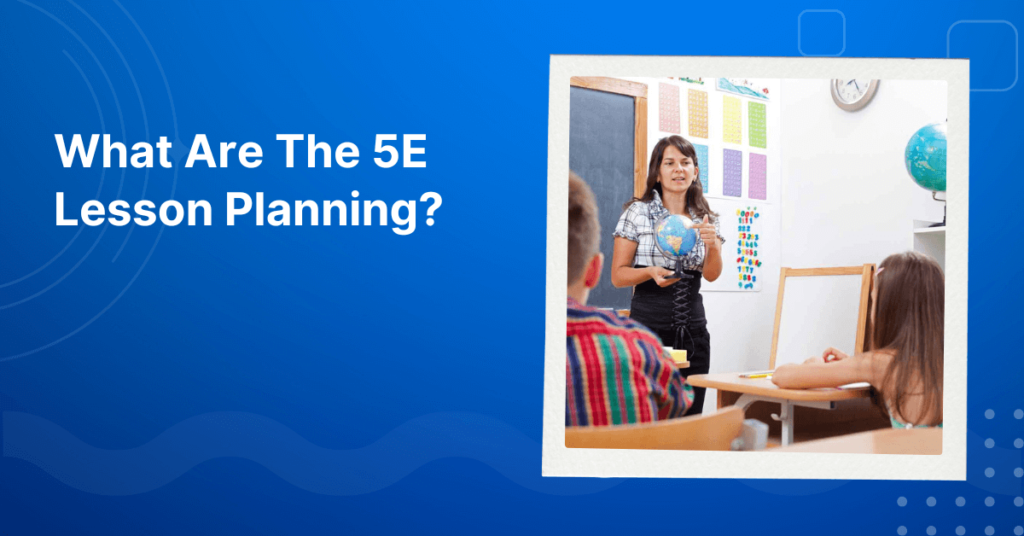One popular approach to lesson planning is the 5E model – a series of interesting activities and smart strategies that help students achieve a specific learning goal. In this post, VTJ will talk about the 5E of lesson planning and its benefits in depth.

What are the 5E lesson planning?
In the 1980s, the Biological Sciences Curriculum Study (BSCS) came up with the 5Es Lesson Planning (5E stands for: Engage; Explore; Explain; Elaborate; Evaluate) – a method that helps teachers create a well-thought-out order to teach that puts students at the center of the learning process.
Engage

This is the first step in the 5E plan. This part is all about getting students’ attention and using what they already know. During this step, teachers want to get students interested and excited about what they will be teaching them. It is very important to start the lesson with an interesting task or “hook” that ties in with what the students already know and are interested in.
An interesting activity could be a short video clip, a question that makes you think, or a hands-on exercise. It’s important to keep this part fun and involved so that students want to learn more.
Explore

In the Discovery section, students are asked to find new knowledge on their own, with the most comfortable mentality. Essentially, the goal is to give students the opportunity to learn more about the topic by doing projects, hands-on activities, and other inquiry-based methods. The focus is on student-centered learning, which means that students ask questions, make observations, and come to their own opinions about what they are learning.
Explain

A turning point in knowledge transfer when conveying content from teachers to students in simple, easy-to-understand language. Besides, teachers can briefly talk about the main events of the lesson through teaching methods such as pictures, videos, and group chats to make the information clear.
Continue Learning: 120+ High and Middle School Debate Topics for Students
Elaborate

Students apply what they have learned to real-life situations. Until solving questions or doing tasks related to the lesson, this section motivates students to think critically and artistically. Therefore, the teacher’s job is to create opportunities for students to practice and improve their skills by giving them tasks that are both important and difficult.
On the other hand, students like to conquer new challenges and recognize the value of success.
Evaluate

Evaluation is the final step in the 5E plan. This is a space for students to express what they have learned and think about their learning process. During this step, teachers can observe how well students understand the lesson’s objectives and give notes on how to improve.
There are many ways to test students, such as through quizzes, lectures, projects, or conversations. Besides, students should also state what they have learned and figure out what they did well and what they could do better.
This is an essential element of lesson planning because it helps teachers make smart choices about future lessons and change their teaching to accommodate those choices.
Explore More Teaching Tips: What are the 4 A’s of lesson planning?
Benefits of Using 5 E’s Lesson Planning
- Encourages students to participate: includes real-world uses, hands-on exercises, and learning based on questions to make learning more valuable and useful.
- Helps kids learn how to think critically and solve problems: Higher-order thinking skills are developed as students discover and make connections between new ideas and what they already know.
- Encourages working together and talking to each other: Promotes learning from each other and building social skills by allowing people to work together, share ideas, and talk about what they’ve found.
- Test many different methods: uses a variety of teaching methods to meet the needs of students with different learning styles and levels of ability. This makes sure that all of the students are interested and pushed.
The Importance of Lesson Planning
Developing lesson plans is a very important task for teachers, and has a major impact on the quality of education that students receive. Writing lesson plans not only demonstrates the teacher’s profound skills and knowledge but also helps students break out of their limits.
Therefore, this requires teachers to be knowledgeable, patient, and highly focused to improve the future knowledge of the country.
Discover Related Guides: 14 Types of Teaching Methods For an Effective Lesson
The 5E model for making lesson planning is a neat and useful way for teachers to make lessons that are fun, have questions, and help students really understand things and think critically. By taking students through the Engage, Explore, Explain, Elaborate, and Evaluate steps, teachers can make sure that all of their students’ needs are met and that all of their students enjoy learning.
FAQs
What are the five parts of planning a lesson?
The 5 parts of planning a lesson help teachers have a clear direction:
- Goals: should be clear, measurable, and in line with the standards in the program.
- Instructional Materials: choose interesting materials that support the lesson goals, such as textbooks, quizzes, videos, and hands-on activities.
- Teaching Strategies and Learning Activities: direct instruction, guided practice, solo work, talks, and learning through questions…
- Assessment: use both official and informal tests to see how much the students learn. This could be a list of questions, self-evaluations, written assignments, projects, quizzes, or tests.
- Closure: go over the main points again, clear up any confusion, make links to real life, and talk about what’s coming up in the next lesson.
What are the 5 points of a lesson plan?
There are 5 points of a lesson plan: Warm-Up, Introduction, Practice, Wrap-Up and Follow-Up
- Warm-up: an engaging “hook-up” activity that attracts interest and stimulates brainstorming.
- Introduction: a brief explanation of the new concept or skill being taught, often using direct instruction and modeling.
- Practice: independent and guided so students can apply what they have learned.
- Summary: a brief review of the main points of the lesson and an opportunity for students to demonstrate understanding.
- Follow-up: assign homework to reinforce lessons and make connections to future learning.
See More Strategies: What is Standardized Testing? Definition, Types, Pros & Cons
What is the 5 model of lesson plan?
The 5 model of lesson plan include:
- Madeline Hunter Model
- 5E Instructional Model
- Understanding by Design (UbD) Model
- ADDIE Model
- Backward Design Model






